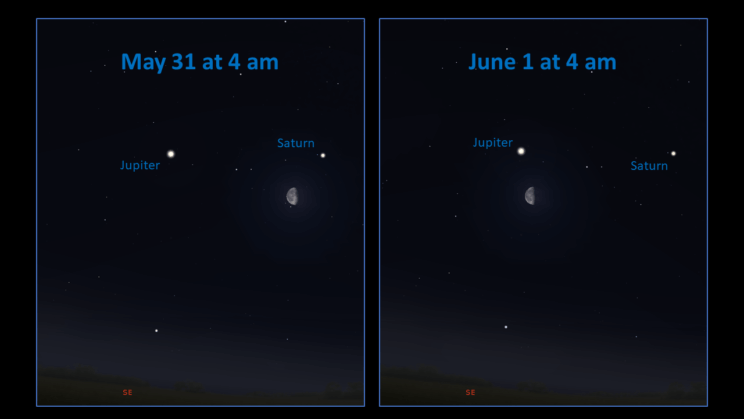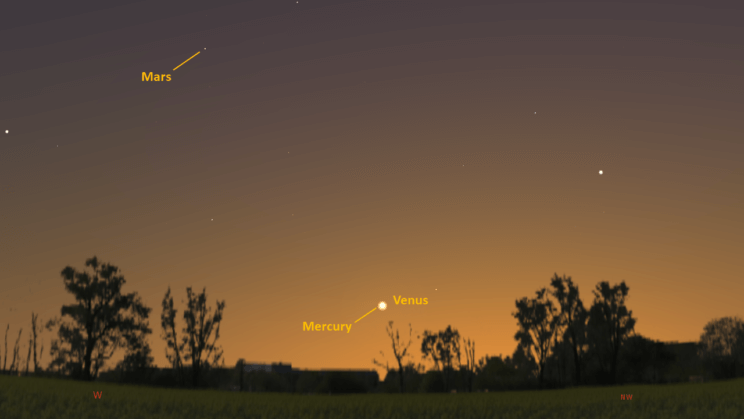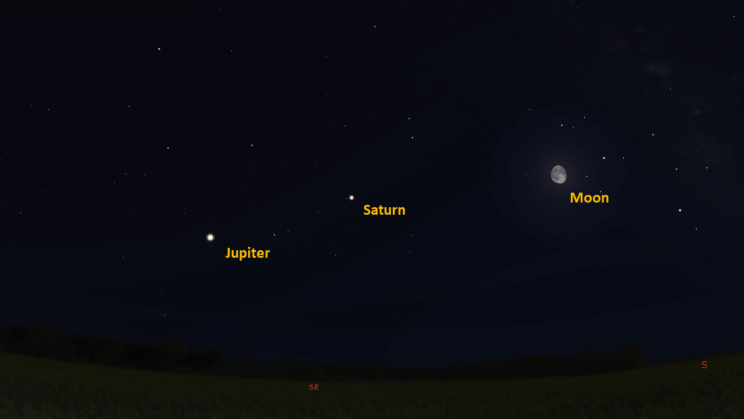This is the Saint Louis Science Center’s NIGHT SKY UPDATE for the week of Friday, May 28, 2021.
Information updated weekly or as needed.
Times given as local St. Louis time, which is Central Daylight Time (CDT). For definitions of terminology used in the night sky update, click the highlighted text. If relying on times posted in Universal Time (UT), St. Louis is -5 hours when CDT.
Public Telescope Viewings
With the changing recommendations from the CDC regarding COVID-19, conversations regarding the return of star parties at the Saint Louis Science Center have begun. We are close to bringing back our public telescope viewings, but a few details still need to be worked out. We will post future updates as we learn more about when we can bring back telescope viewings.
Observing Highlight of the Week

Moon, Saturn and Jupiter Conjunctions
Credit: Stellarium, EG
For early birds this week, the Moon will visit the planets Saturn and Jupiter in southeast before sunrise. Each month the Moon passes by each planet as the Moon completes its orbit about the Earth. Like the Moon, planets are always in a zodiac constellation. Saturn can be found in Capricornus and Jupiter is found in Aquarius.
On May 30, 2021, there will be a conjunction of the Moon and Saturn. At their closet approach to each other, the Moon and Saturn will be about 4° apart. This happens before the Moon and Saturn rise but they will still make a nice pair of targets for binocular observers to see in one field of view as they rise after midnight becoming visible in the early morning hours of May 31.
On June 1, 2021, the Moon and Jupiter will reach conjunction being separated by roughly 4°. The conjunction occurs at 4:00 a.m. and can be viewed by looking to the southeast. The Moon will pass south of Jupiter and will be a 21-day old moon which is a waning gibbous phase. If you have binoculars, try to catch a view of our Moon and the Galilean moons orbiting Jupiter.
The Sun and Moon

The Moon as seen from the International Space Station, on July 31, 2011.
Credit: NASA
Sunrise is at 5:40 a.m. on Friday, May 28 and sunset is at 8:17 p.m. providing us with about 14.5 hours of daylight. Even after sunset, the light from the Sun will dimly illuminate our sky for about 2 hours. This period is called twilight, which ends around 10:10 p.m. this week. For those with a sundial, local noon occurs around 12:59 p.m. this week.
| Day | Sunrise | Sunset |
|---|---|---|
| 2021-05-28 | 5:40 a.m. | 8:17 p.m. |
| 2021-05-29 | 5:40 a.m. | 8:18 p.m. |
| 2021-05-30 | 5:39 a.m. | 8:19 p.m. |
| 2021-05-31 | 5:39 a.m. | 8:19 p.m. |
| 2021-06-01 | 5:38 a.m. | 8:20 p.m. |
| 2021-06-02 | 5:38 a.m. | 8:21 p.m. |
| 2021-06-03 | 5:38 a.m. | 8:21 p.m. |
| 2021-06-04 | 5:37 a.m. | 8:22 p.m. |
| 2021-06-05 | 5:37 a.m. | 8:23 p.m. |
Moon
Moonrise for Friday, May 28 occurs at 11:14 p.m. and moonset will occur at 8:38 a.m. on the following morning. On Friday, May 28 the Moon will exhibit a waning gibbous phase with 92% of the lunar disk illuminated. Last quarter moon occurs on June 2 at 2:24 a.m.
International Space Station (ISS) Observing

Visible passes of ISS from St. Louis for the week of May 28 occur during evening hours. The best passes this week occur on the evenings of May 30 and June 3. Use the table below for information about these and other visible passes this week.
Catch ISS from St. Louis starting Friday, May 28
| Date | Starts | Max. altitude | Ends | |||||||
|---|---|---|---|---|---|---|---|---|---|---|
| Time | Alt. | Az. | Time | Alt. | Az. | Time | Alt. | Az. | ||
| 28 May | -2.6 | 22:17:13 | 10 | NW | 22:20:21 | 34 | NNE | 22:12:02 | 31 | ENE |
| 29 May | -1.9 | 21:30:03 | 10 | NNW | 21:32:52 | 24 | NNE | 21:35:20 | 12 | E |
| 29 May | -1.8 | 23:06:34 | 10 | WNW | 23:08:17 | 26 | W | 23:08:17 | 26 | W |
| 30 May | -1.4 | 20:42:57 | 10 | NNW | 20:45:17 | 17 | NNE | 20:47:39 | 10 | ENE |
| 30 May | -3.9 | 22:19:06 | 10 | NW | 22:22:28 | 81 | SW | 22:22:39 | 77 | S |
| 31 May | -3.4 | 21:31:46 | 10 | NW | 21:35:05 | 57 | NE | 21:37:02 | 22 | ESE |
| 01 Jun | -2.2 | 22:21:34 | 10 | WNW | 22:24:20 | 24 | SW | 22:24:27 | 24 | SW |
| 02 Jun | -3 | 21:33:52 | 10 | WNW | 21:37:05 | 43 | SW | 21:38:58 | 21 | SSE |
| 03 Jun | -3.7 | 20:46:24 | 10 | NW | 20:49:46 | 80 | SW | 20:53:07 | 10 | SE |
| 04 Jun | -1.2 | 21:37:03 | 10 | W | 21:38:50 | 14 | SW | 21:40:37 | 10 | SSW |
| 05 Jun | -1.9 | 20:48:52 | 10 | WNW | 20:51:37 | 24 | SW | 20:54:23 | 10 | S |
Magnitude (Mag): The Measure of brightness for a celestial object. The lower the value is, the brighter the object will be.
Altitude (Alt): The angle of a celestial object measured upwards from the observer’s horizon.
Azimuth (Az): The direction of a celestial object, measured clockwise from an observer’s location with north being 0°, east being 90°, south being 180° and west being 270°.
For information about ISS flyovers and other visible satellites, visit www.heavens-above.com
Detailed information regarding all unmanned exploration of our universe, missions past, present, and planned, can be found at Jet Propulsion Laboratories:
The Visible Planets

Looking West, at 8:45 pm, May 28, 2021
Credit: Stellarium, EG,

Looking Southeast, at 3:00 am, May 29, 2021
Credit: Stellarium, EG
This week, five naked eye planets are visible. Mercury and Venus can be found in the west northwest just after sunset. Mars is found in the west after sunset. Jupiter and Saturn can be found in the southeast before sunrise.
Mercury
Mercury is past greatest elongation for the current evening apparition. Mercury is now head back towards the Sun as it heads towards inferior conjunction on June 10, 2021. Unfortunately, this means we will see less and less of Mercury each day. You can still look for Mercury about 30 minutes after sunset but each day the planet will be harder to find. By the end of May, Mercury will be too low to easily see.
Venus
Venus is well into another evening apparition. By 8:45 p.m., Venus will be about 8° above the west-northwest horizon. As 2021 continues, we will see Venus climb higher in the western sky after sunset until October 29 when it reaches maximum eastern elongation. After this date Venus will start to head back towards the Sun as it approaches inferior conjunction on January 8, 2022.
Mars
Currently Mars appears as a 1.7-magnitude object that will be visible high in the west about 40 minutes after sunset. Mars sets by 11:22 p.m.
Jupiter
Jupiter is visible in the southeast before sunrise. Jupiter rises at 1:29 a.m. and will be easy to see in the southeast by 2:30 a.m.
Saturn
Saturn has returned to our morning sky. Saturn rises at 12:39 a.m. and will be easy to spot by 1:30 a.m. looking southeast.
James S. McDonnell Planetarium
Night Sky Update: May 28-June 5, 2021






